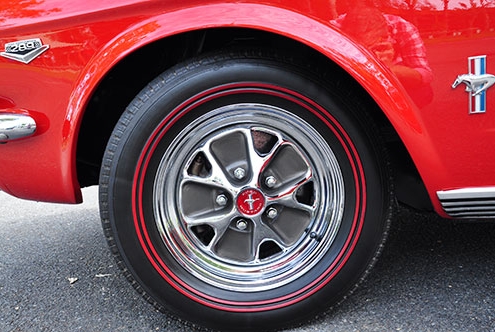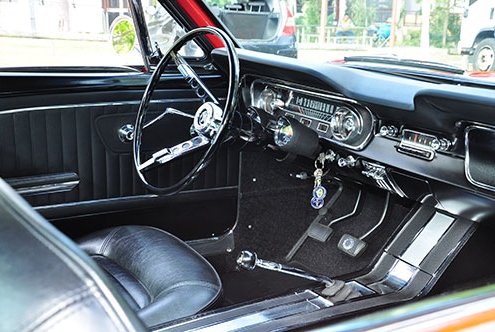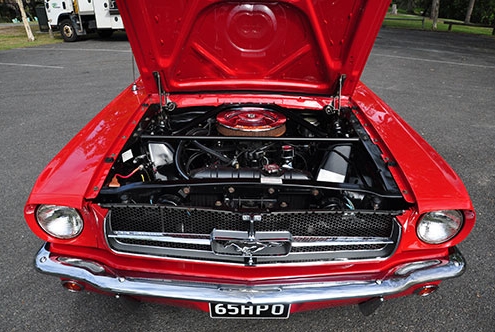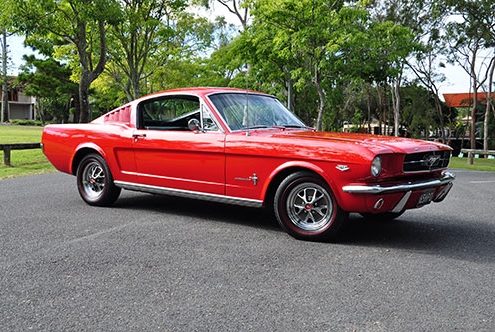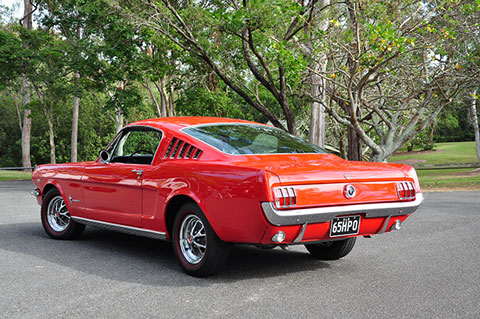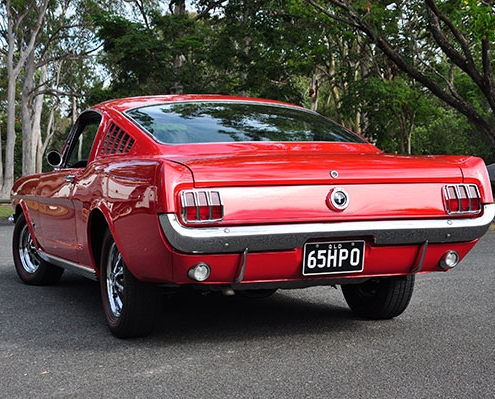1955 K-Code Mustang Fastback
Owner: Philip McCracken
Published: July 2019
Philip McCracken’s wife had a good idea. Buy a recently imported Mustang, spend some money and time tidying it up, probably a paint job, and sell it on.
Then Philip McCracken found a K-code Fastback.
17 years later, he’s finally put the ‘quick project’ Mustang on the market after pouring tens of thousands of dollars and countless man hours into bringing this rare Pony back as close as possible to how it rolled off the assembly line in 1964.
What makes the K-code so special is not only its high-performance additions, but just how few were made.
“The Mustangs had four different codes,” explains Philip. “T for the basic six-cylinder version, the base V8 model was the C, the A with a four-barrel carbie and then the K code.”
While the K-codes shares the 289ci V8 of the other models, its four-barrel carbie has bigger secondaries, making 600 CFM (cubic feet per minute of airflow) compared to the next code down’s 480 CFM.
It also has, among other extras, solid lifters, screw-in studs on the heads, and conrods, pistons, heads and valves all designed to take high revs, delivering 271hp at 6000 RPM straight from the factory. That, Philip says, was a pretty hot deal off the showroom floor.
“For the 1965 model, 7200 K-codes were produced, which was 0.7 per cent of the Mustangs built that year.
“There is a world register of K-codes, which this car went on in 1981, and as of today there’s only 1500 on the register, so it’s a fairly rare bit of work.”
In 2002, Philip went with a friend to look at Mustang – a 1969 coupe the owner had bought new in Canada and that had just 31,000 miles on the clock.
While checking out that car, however, Philip spied something under blankets in the corner of the garage.
That something was this K-code, the first Philip had seen, and a very different car to the one it is today.
“We talked all afternoon and at the end he said he’d sell it to me,” says Philip.
“I went away, did some research and learnt just how rare and special these cars are. Plus, it was going to be as close as I’d ever get to a Shelby, as these are the cars Carroll Shelby based his Mustangs on.”
They made a deal, and Phil began a restoration of the car that would stretch over nine years.
Thanks to VIN and data plates, plus online resources, it’s a relatively easy task to establish what each Mustang sported when it rolled off the line, including paint colour and interior finish.
For Philip, there was only one end game worth considering – restoring the K-code back to the original.
That included converting it back to left-hand-drive from right-hand-drive, which was mandatory in Queensland to register a car in the 1970s.
“It was a typical 1970s conversion, just swapping the steering and pedals over, basically, and Colin Chapman in Logan Village, who’s been doing Mustang conversions since the 1970s, did the work,” says Philip.
“We sourced a left-hand dash from someone who’d done a RHD conversion, drilled out the original factory welds and put the new one in.
“The car had not run since 1976 – the motor was seized and the bores very rusty – when it came time to do the motor, Shane Moran at SWC Automotive bored it out to 30,000 and then 60,000 and it was still leaching rust.
“He said we’d have to throw away the block and use a new one, but I said no, as the K-codes have a VIN stamped in the block and transmission – a close-ratio top loader – so that’s hen’s teeth stuff.”
The previous owner bought the car in 1981 in Gladstone. It was painted yellow with black stripes, had flared guards and brackets on the sills indicating it had either side exhausts or a stoneflectors.
Sadly, Philip ran into issues with the original panel beater tasked with the job of getting the body back to showroom condition, and the project was put back by at least 12 months with the car sitting idle at Robbo’s (Robert Haken) Logan Village Smash.
“When work commenced, Robbo rang to tell me the car was so out of shape we wouldn’t be able to get the motor back in,” says Philip. “So, it was back on the rig, straightened up and then back to bare metal before being sprayed in the original colour, Rangoon Red.
“Robbo used PPG paint and in the sun the colour just pops. The paint on the car now is exactly as it was when it came off the gun in 2007 and that is a real testament to Robbo.”
Philip got the rolling shell back towards the end of 2007 and then put the car back together himself in his grandmother-in-law’s single-bay garage.
“I’ve worked in a library for 32 years, I’ve no mechanical background but I’m pretty good at pulling things apart and putting them back carefully,” says Philip. “Plus you can buy factory exploded-view diagrams for absolutely everything, and I had a great resource in the online community at hipo-mustang.com.”
Philip revealed there’s a few rarities on the car that required special treatment during the rebuild.
“The fuel pumps in 1965 were crimped together, but in 1966 they went to a screw together so you could put a kit through them. A guy in the U.S. found a company that could uncrimp and crimp them back together, but they needed to do 50 at a time.
“Word got out, and all these Shelby owners, who had original pumps sitting on the shelf, got excited and the company had 50 in three weeks!
“I got in on the second lot and it came back like new. It’s never leaked, never missed a beat.
“The carbie is another rarity, an Autolite 4100. In the 1970s the Holley carbies came out, and because the Autolites can be a bit finicky to keep in tune, a lot of them were replaced and lost.
“When I bought the car, it had a Holley 600 with Weiand manifold, but the then-owner gave me a plastic bag and said, ‘I think that’s the carby’.
“I’ve had a lot of luck with this car, but I also went to crazy lengths to get it back to original.”
Come 2011, Philips pony was ready to gallop again, and he decided to debut it in grand fashion, entering it in the Mustang Owners Club Australia Nationals in Brisbane.
He won a silver in what was his first time showing a car.
“There were plenty of people saying that was a huge effort for a first car,” said Philip.
“From there, we’ve entered State concourses and won gold, and in 2016 won another silver at the nationals.
“I retired the car from concoursing after that as it’s a huge amount of work and, really, I did all this to drive the car more than show it.”
The car’s been a regular on club runs as well as making a couple of appearances at Lakeside Park raceway ‘running at full noise, which is a lot of fun,’ Philip said with a grin.
But now, Philip’s looking to pass this rare beauty on to another.
It’s a matter of practicality in the main.
“The K-code has a black interior and no air conditioning, and it gets pretty warm in a Queensland summer,” he said. “We also have a 1966 C-code coupe that was one of 161 Ford Australia bought in to promote the Mustang-bred XR Falcon V8. It’s pretty rare as well.
“So, the plan now is to sell the K-code and buy a new Mustang, so we’ll have a classic and a contemporary.”
While the photos on these pages convey just how incredible this car is, seeing it in real life is another level. It truly is a testament not only to the many experts who worked on it, but to Philip’s single-minded passion to resurrect this rare Mustang and put it back on the road in a condition as close as possible to when it rolled out of the factory.
Whoever owns it next will have acquired a Mustang that really is one in a million.
If you’re interested in getting your hands on this piece of automotive history, it is for sale. Contact Philip at philmac271@hotmail.com for all the details.
Source: Motor Trader E-Magazine (July 2019)
10 Jul 2019






